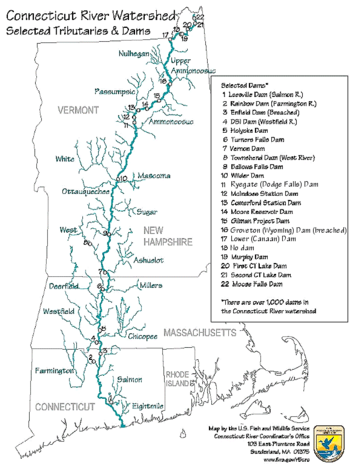Connecticut River: Difference between revisions
Jump to navigation
Jump to search

Pat Palmer (talk | contribs) mNo edit summary |
Pat Palmer (talk | contribs) mNo edit summary |
||
| (8 intermediate revisions by the same user not shown) | |||
| Line 1: | Line 1: | ||
{{subpages}} | |||
{{Image|Connecticut River Map.png|right|350px|The Connecticut River flows through the U.S. states of New Hampshire, Vermont, Massachussetts and Connecticut.}} | |||
The '''Connecticut River''' is the longest river in the [[New England]], flowing roughly southward from just south of [[Quebec]] for 406 miles through NH, VT, MA and CT until it reaches the [[Long Island Sound]]. Its watershed includes parts of five U.S. states and one Canadian province, via 148 tributaries, 38 of which are major rivers.<ref name="ctriver.org" /> The river valley is home to highly productive farmland and passes through the middle of the metropolitan region of approximately two million people surrounding [[Springfield, Massachusetts]], and [[Hartford, Connecticut]]. | |||
The | The river and its tributaries are highly dammed, with as many as 65 major dams that are a primary source of hydroelectric power in the region. | ||
==Notes== | |||
<references> | |||
<ref name="ctriver.org"> | |||
{{cite web| url=http://www.ctriver.org/river-resources/about-our-rivers/watershed-facts/| title=Watershed Facts| publisher=Connecticut River Watershed Council| access-date=August 9, 2016| archive-url=https://web.archive.org/web/20160805023222/http://www.ctriver.org/river-resources/about-our-rivers/watershed-facts/| archive-date=August 5, 2016| url-status=live}} | |||
</ref> | |||
</references> | |||
Latest revision as of 09:18, 7 August 2023
The Connecticut River is the longest river in the New England, flowing roughly southward from just south of Quebec for 406 miles through NH, VT, MA and CT until it reaches the Long Island Sound. Its watershed includes parts of five U.S. states and one Canadian province, via 148 tributaries, 38 of which are major rivers.[1] The river valley is home to highly productive farmland and passes through the middle of the metropolitan region of approximately two million people surrounding Springfield, Massachusetts, and Hartford, Connecticut.
The river and its tributaries are highly dammed, with as many as 65 major dams that are a primary source of hydroelectric power in the region.
Notes
- ↑ Watershed Facts. Connecticut River Watershed Council.
